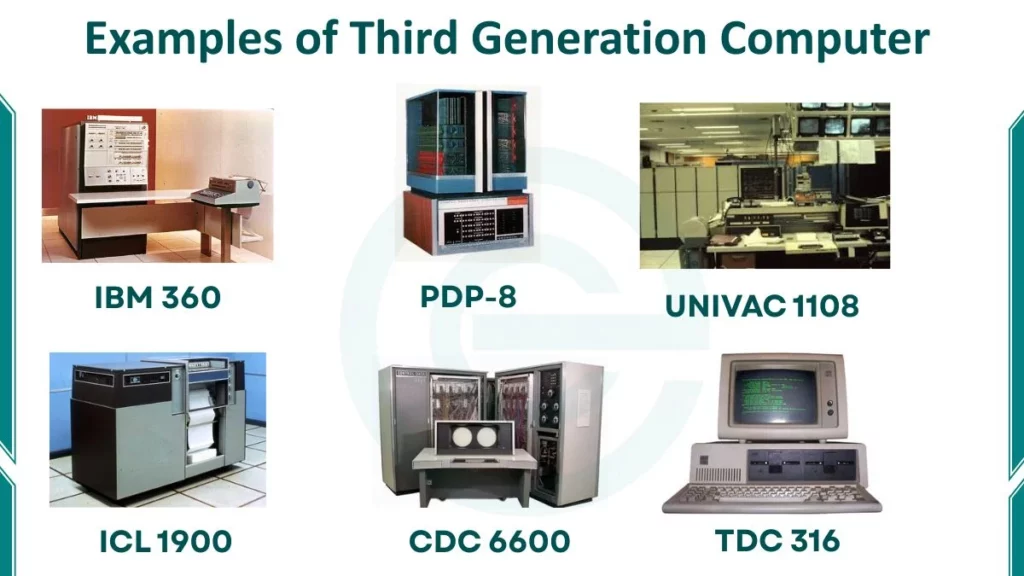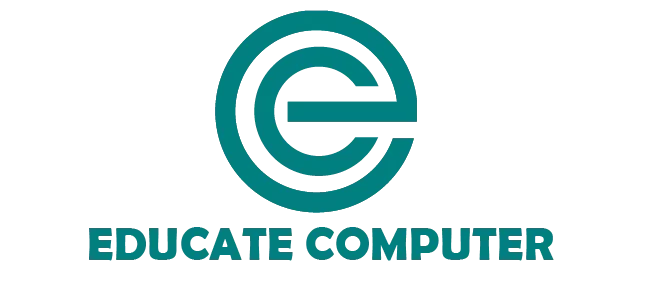Examples of Third Generation computers include IBM 360, PDP-8, Honeywell 6000, UNIVAC 1108, ICL 1900, CDC 6600, IBM 370, PDP-11, TDC 316, and Burroughs B6500. We discuss all these examples in detail below.
Third-generation computers were built between 1965 and 1975 and marked a major shift in computer technology. They used integrated circuits (ICs) instead of transistors, which made them faster, smaller, and more reliable.

Examples of 3rd Generation Computers
The following is a list of examples of third generation computer:
- IBM 360
- PDP-8
- Honeywell 6000
- UNIVAC 1108
- ICL 1900
- CDC 6600
- IBM 370
- PDP-11
- TDC 316
- Burroughs B6500
Now, let’s discuss each example in detail.
1. IBM 360 (International Business Machines System/360)
IBM 360 was introduced in 1964 by IBM. It is one of the most famous computers of the third generation and supports both scientific and business applications.
It uses integrated circuits and supports a wide range of compatible models, allowing easy upgrades.
Features:
- Uses integrated circuits for processing.
- Compatible with multiple input and output devices.
- Supports both scientific and commercial programming.
- Can perform multitasking.
- Uses magnetic disk storage.
Purpose:
IBM 360 is used in universities, research labs, and businesses for calculations, data processing, and engineering work.
Example Insight:
IBM 360 sets a new industry standard by introducing compatibility across different computer models.
2. PDP-8 (Programmed Data Processor-8)
PDP-8 was developed by Digital Equipment Corporation (DEC) in 1965. It is considered the first successful minicomputer.
It is affordable and small enough to fit in offices and laboratories. This makes computing accessible to smaller organizations.
Features:
- Built with integrated circuits.
- Small size and low cost.
- Uses magnetic core memory.
- Supports real-time data processing.
- Input and output through teletype or paper tape.
Purpose:
PDP-8 is used for laboratory control, small business applications, and educational training.
Example Insight:
PDP-8 revolutionizes computing by making it affordable and practical for smaller users.
3. Honeywell 6000 Series
Honeywell 6000 Series was introduced in 1965 as a mainframe computer family designed for both business and scientific applications. These systems are known for their reliability, multitasking ability, and modular design. This allows users to expand system capabilities as needed.
It provides multitasking and time-sharing features. It allows multiple users to operate simultaneously.
Features:
- Uses IC technology for faster processing.
- Supports multiple programming languages.
- Provides time-sharing and batch processing.
- Has magnetic core and disk storage.
- Includes an advanced operating system.
Purpose:
Honeywell 6000 is used in industries for data management, payroll, and large-scale business operations.
Example Insight:
Honeywell 6000 Series competes with IBM systems and gains popularity for its reliability and flexibility.
4. UNIVAC 1108
UNIVAC 1108 was developed by Sperry Rand in 1965. It is a powerful scientific and business computer that uses integrated circuits. It is a versatile system that introduces multiprocessing capabilities. This allows different programs to run at once.
Features:
- Built with ICs for high speed.
- Supports multitasking and multiprocessing.
- Uses magnetic drum and disk storage.
- Provides time-sharing capabilities.
- Compatible with advanced programming languages.
Purpose:
UNIVAC 1108 is used for banking, engineering analysis, and scientific simulations.
Example Insight:
UNIVAC 1108 demonstrates how integrated circuits enhance processing speed and efficiency.
5. ICL 1900 Series
ICL 1900 was launched in 1965 by International Computers Limited (UK). It is mainly used for business administration, accounting, and scientific research.
It supports multiple terminals and allows users to interact with the computer simultaneously. This makes it an important system in European computing history.
Features:
- Uses integrated circuits.
- Supports multiple terminals for users.
- Provides reliable data storage with magnetic disks.
- Compatible with COBOL and FORTRAN languages.
- Includes time-sharing capability.
Purpose:
ICL 1900 is used in offices, universities, and government departments for data handling and accounting.
Example Insight:
ICL 1900 helped promote computerization in the UK and Europe during the 1960s.
6. CDC 6600 (Control Data Corporation 6600)
CDC 6600 was introduced in 1964 by Control Data Corporation. It is considered the first supercomputer of its time. It could perform three million instructions per second. This makes it the fastest computer of its era.
Features:
- Uses integrated circuits and parallel processing.
- High-speed floating-point arithmetic.
- Includes multiple functional units for efficiency.
- Uses magnetic core memory.
- Built for scientific and engineering research.
Purpose:
CDC 6600 is used for weather forecasting, atomic research, and complex simulations.
Example Insight:
CDC 6600 becomes the world’s fastest computer of its era, pioneering the concept of supercomputing.
7. IBM 370
IBM 370 was introduced in 1970 as an advanced mainframe system. It is a successor to IBM 360 and provides improved performance, storage, and reliability. It features large-scale integration (LSI) technology and introduces virtual memory that enhances performance.
Features:
- Uses large-scale integration (LSI) circuits.
- Supports virtual memory and multitasking.
- Compatible with IBM 360 software.
- Offers high-speed data transfer.
- Supports multiple terminals.
Purpose:
IBM 370 is used in banks, airlines, and research organizations for high-volume data processing.
Example Insight:
IBM 370 establishes IBM’s dominance in the mainframe market with improved performance and backward compatibility.
8. PDP-11
PDP-11 was developed by Digital Equipment Corporation in 1970. It is one of the most successful minicomputers ever made and features a modular design, which allows easy expansion and customization. It is compact, user-friendly, and supports various operating systems.
Features:
- Uses integrated circuits for processing.
- Modular design allows easy upgrades.
- Supports real-time data processing.
- Compatible with multiple programming languages.
- Includes built-in debugging features.
Purpose:
PDP-11 is used in engineering, automation, and educational fields.
Example Insight:
PDP-11 becomes a milestone in computer design and strongly influences the development of future microprocessors.
9. TDC 316
TDC 316 was introduced by Electronics Corporation of India Limited (ECIL) in the early 1970s. It is a 16-bit minicomputer widely used in research and industry. It proves that India is capable of developing competitive computing technology.
Features:
- Uses IC-based design for fast processing.
- Provides real-time control applications.
- Compact and reliable.
- Supports multiple input-output devices.
- Designed for continuous operation.
Purpose:
TDC 316 is used in process control, laboratory experiments, and defense applications.
Example Insight:
TDC 316 marks India’s progress in computer manufacturing and industrial automation.
10. Burroughs B6500
Burroughs B6500 was introduced in 1969 by Burroughs Corporation. It is designed mainly for business and commercial computing and stands out for its stack-based architecture. This system also supports high-level programming languages.
Features:
- Uses integrated circuits for performance.
- Supports stack-based architecture.
- Handles multiple tasks simultaneously.
- Uses magnetic disk and drum storage.
- Supports ALGOL and COBOL languages.
Purpose:
Burroughs B6500 is used for business applications, financial processing, and database management.
Example Insight:
Burroughs B6500 introduces advanced software handling and becomes a favorite for commercial use.
Also Read:
